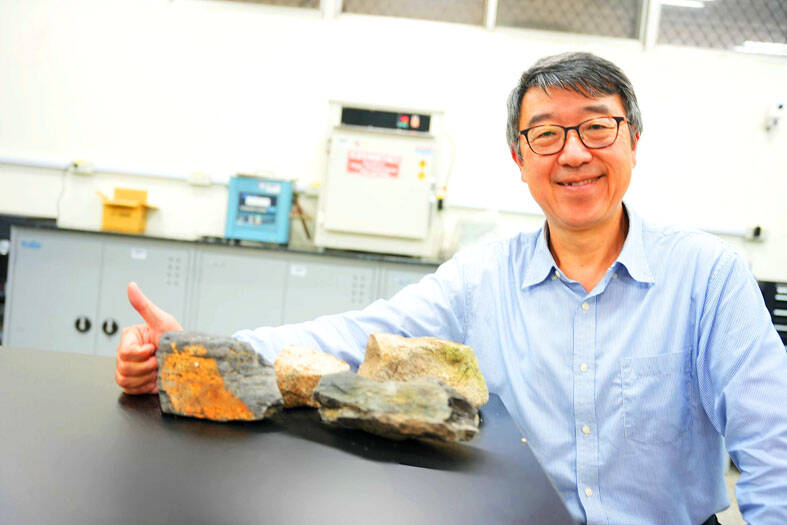Examining the relationship between permeability and depth of slate might provide an easier means to evaluate the feasibility of geothermal projects before a detailed site investigation, Chinese-language media reported on Monday, citing a National Central University researcher.
Dong Jia-jyun (董家均) — a professor in the university’s Graduate Institute of Applied Geology and a contributing author to the paper “Estimating the Permeability-Depth Relation of Slate Formation for Geothermal Project,” which the Rock Mechanics and Rock Engineering journal published on May 4 — said that Taiwan’s location on the Eurasian and the Philippine tectonic plates means that rapid mountain-building activity has raised hot slate to shallower regions, making the region a viable candidate for developing geothermal power generation.
“While the fluid flow capability of slate formations has not been well investigated internationally, the study proposes a procedure to evaluate the permeability-depth relationship in slate formations,” Dong said.

Photo courtesy of National Central University
The researchers primarily studied the Hungyeh Formation in Taitung to gauge the permeability and gap size of fractures in the rock.
Using equipment donated by Japanese professors during a previous project, the group conducted tests on samples taken from a bore hole to propose the evaluation method, which can be conducted on unassessed sites before boreholes are dug, Dong said.
As emphasis on rock mechanics and rock engineering increases with national infrastructure projects such as the High Speed Railway, dams, tunnels and renewable energy development, the pre-assessment can provide a scientific basis for geothermal power generation projects and allow local governments to gauge the economic viability of such ventures, he said.
The method could provide authorities in regions outside Taiwan that have similar geological parameters, such as the Harz Mountains in Germany’s Gottingen region, to gauge the viability of developing geothermal power generation, he added.

SHIPS, TRAINS AND AUTOMOBILES: The ministry has announced changes to varied transportation industries taking effect soon, with a number of effects for passengers Beginning next month, the post office is canceling signature upon delivery and written inquiry services for international registered small packets in accordance with the new policy of the Universal Postal Union, the Ministry of Transportation and Communications said yesterday. The new policy does not apply to packets that are to be delivered to China, the ministry said. Senders of international registered small packets would receive a NT$10 rebate on postage if the packets are sent from Jan. 1 to March 31, it added. The ministry said that three other policies are also scheduled to take effect next month. International cruise ship operators

HORROR STORIES: One victim recounted not realizing they had been stabbed and seeing people bleeding, while another recalled breaking down in tears after fleeing A man on Friday died after he tried to fight the knife-wielding suspect who went on a stabbing spree near two of Taipei’s busiest metro stations, Taipei Mayor Chiang Wan-an (蔣萬安) said. The 57-year-old man, identified by his family name, Yu (余), encountered the suspect at Exit M7 of Taipei Main Station and immediately tried to stop him, but was fatally wounded and later died, Chiang said, calling the incident “heartbreaking.” Yu’s family would receive at least NT$5 million (US$158,584) in compensation through the Taipei Rapid Transit Corp’s (TRTC) insurance coverage, he said after convening an emergency security response meeting yesterday morning. National

PLANNED: The suspect visited the crime scene before the killings, seeking information on how to access the roof, and had extensively researched a 2014 stabbing incident The suspect in a stabbing attack that killed three people and injured 11 in Taipei on Friday had planned the assault and set fires at other locations earlier in the day, law enforcement officials said yesterday. National Police Agency (NPA) Director-General Chang Jung-hsin (張榮興) said the suspect, a 27-year-old man named Chang Wen (張文), began the attacks at 3:40pm, first setting off smoke bombs on a road, damaging cars and motorbikes. Earlier, Chang Wen set fire to a rental room where he was staying on Gongyuan Road in Zhongzheng District (中正), Chang Jung-hsin said. The suspect later threw smoke grenades near two exits

The Forestry and Nature Conservation Agency yesterday launched a gift box to market honey “certified by a Formosan black bear” in appreciation of a beekeeper’s amicable interaction with a honey-thieving bear. Beekeeper Chih Ming-chen (池明鎮) in January inspected his bee farm in Hualien County’s Jhuosi Township (卓溪) and found that more than 20 beehives had been destroyed and many hives were eaten, with bear droppings and paw prints near the destroyed hives, the agency said. Chih returned to the farm to move the remaining beehives away that evening when he encountered a Formosan black bear only 20m away, the agency said. The bear